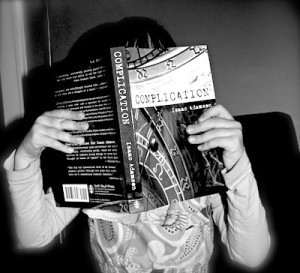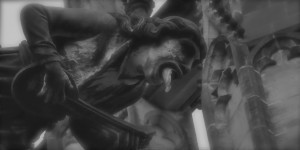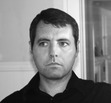Isaac Adamson's Blog, page 3
July 10, 2012
Josefov
In today’s excerpt from Prague Unbound, we take a look at Prague’s all but vanished old Jewish quarter
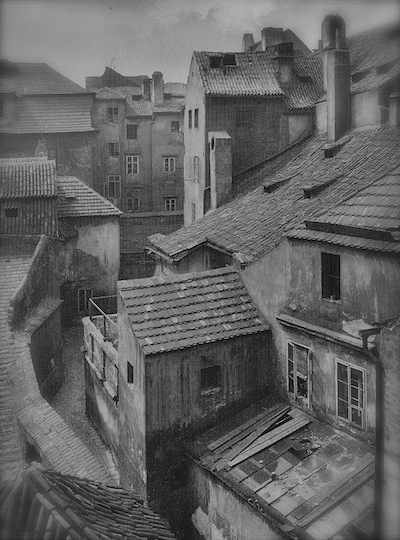
Legend has it the first Jews came to Prague following the destruction of the Temple in Jerusalem during the days of the Roman Empire, but scant evidence exists of a Jewish presence in the city until the 10th century. Since then, Prague’s Jewish ghetto has gone by many names – Židovské město (Jewish Town), the Fifth Quarter, Josefstadt (after Emporer Josef II who championed religious tolerance), and Josefov (the same in Czech).
A city-within-a-city, the area’s relationship with greater Prague has always been a troubled one. Beginning in the 11th century Jews were required to wear pointy hats and a yellow Star of David on their clothing, had to obey a curfew and were not permitted to live outside the ghetto. For much of its history, the ghetto remained enclosed by walls topped with barbed wire, both to isolate the Jews from fearful gentiles and to protect the ghetto’s citizenry against anti-Semitic rampages whenever Christians suspected those people in the funny hats had desecrated the Host or used the blood of children as a special ingredient in unleavened Passover bread. Most of the Jewish population in Prague was killed or driven out during a pogrom in 1389, and it was to protect against such violence that the esteemed Rabbi Loew created the Golem in the 16th century.
During the tolerant reigns of Emporers Rudolf II and his brother Mathias, the Fifth Quarter flourished. Some of its most important buildings were created during this time (many with the help of wealthy mayor Mordecia Maisel) including the High Synagogue, the Maisel Synagogue, and the original Jewish Town Hall (upon which you can still see the Hebrew Clock where the hands move in reverse).
But as usual destruction followed. Most of the Jewish Quarter burned down in 1689, and in 1745 Hapsburg Queen Maria Theresa had the Jews forcibly expelled from Prague.
They would return after her death, and by the early 1800s, the Fifth Quarter, (now called Josefstadt in honor of Emperor Josef II, who’d granted them religious freedom) contained the largest Jewish population in the world and boasted one synagogue for every ten households.
But when Jews were allowed for the first time to live outside the ghetto walls in 1848, nearly all but the poorest or most orthodox among them left for greener pastures. The area quickly became an overcrowded slum, with 186,000 living in squalor, one house sometimes containing as many as two hundred people. Among them were likely to be beggars, criminals, whores, gamblers and all the sorts of people your mother would have warned you about had she stuck around. Taverns and brothels with names like The Black Eagle and The Old Lady and The Cunning Beast flourished — as did rats. Lack of sanitation and drinking water made the teeming slum a breeding ground for all manner of disease.
The Slum Clearance Law of 1893 put an end to all that, with the city council declaring the entire area unfit for human habitation and razing it to the ground. The only buildings spared destruction were a handful of synagogues, the Jewish Town Hall and the Old Jewish Cemetery.
But the ghetto lived on, enflaming the imaginations of many writers in the wake of its hasty destruction. Gustav Meyrink’s popular 1914 proto-horror novel The Golem was among the first to trade on the ghetto’s dark reputation, its doomed narrator relating, “I felt as if the houses were staring down at me with malicious expressions full of nameless spite: the doors were black, gaping mouths in which the tongues had rotted away.…”
Paul Leppin, whose paranoid tales of decadence and erotic dissolution were set inside Josefov salons described the ghetto as “a steep, gloomy maze of narrow streets from which no weather could blow the stench of decay and dank, moulding walls and where, in summer, a poisonous breath streamed forth from the open doors.”
In his correspondence, Franz Kafka summed up the feelings of many who could not shake its menacing shadow. “In us all it still lives – the dark corners, the secret alleys, shuttered windows, squalid courtyards, rowdy pubs and sinister inns…Inside we tremble just as before in the ancient streets of our misery…With our eyes opened we walk through a dream: ourselves only a ghost of a vanished age.”
I need not tell you, Dear Reader, what dreams you walk through, what ghosts of vanished ages dwell within you.
(Photo via Jindrich Eckert – 1908)
June 21, 2012
The Charles Bridge
In today’s excerpt from Prague Unbound, we take a look at one of the city’s most iconic structures — The Charles Bridge.
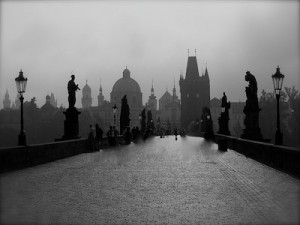 Though universally recognized as one of the most beautiful bridges in the world, from an art historian’s perspective, the Charles Bridge is a aesthetic Frankenstein’s monster pieced together from the bones of various historical eras, the flesh of varied artistic styles, the corrupted organs of conflicting political and religious agendas. Deconstructed by Swedish cannonballs and Vltava floods, reconstructed and renovated multiple times since its beginnings in 1357, the bridge is perhaps best seen as a semiotic pastiche writ in stone, a cipher morphing brick-by-brick through centuries of tumult and…
Though universally recognized as one of the most beautiful bridges in the world, from an art historian’s perspective, the Charles Bridge is a aesthetic Frankenstein’s monster pieced together from the bones of various historical eras, the flesh of varied artistic styles, the corrupted organs of conflicting political and religious agendas. Deconstructed by Swedish cannonballs and Vltava floods, reconstructed and renovated multiple times since its beginnings in 1357, the bridge is perhaps best seen as a semiotic pastiche writ in stone, a cipher morphing brick-by-brick through centuries of tumult and…
Christ Jesus but we’re boring ourselves silly.
To the legends and myths, to the blood and agony and death…
The thirty statues lining the bridge constitute a panoply of suffering likely unrivaled by any 500-meter stretch on earth. Those age-blackened* stone figures looking mournfully on as millions of tourists parade across while locals play accordions and hawk mass-produced watercolors and make puppets dance include:
Saint Barbara, who was imprisoned, tortured and finally beheaded (the last by her own father, no less).
Saint Margaret the Virgin, who was once swallowed by Satan himself before escaping, only to be thrown in a cauldron of boiling water (didn’t kill her), burned alive (didn’t kill her), and beheaded (killed her).
Saint Christopher, decapitated.
Saint Ludmila of Bohemia, strangled by her own veil at the behest of her daughter-in-law.
Saint Lutgardis, who levitated, dripped blood from her forehead, and was stricken blind for the last 11 years of her life.
Saint Adelbert, martyred for chopping down oak trees sacred to Prussian pagans. Decapitated.
Saint Wenceslas I, murdered by his brother, Boleslav the Cruel.
Saint Sigismund, who ordered his own son strangled when the kid insulted Sigismund’s second wife. Sigismund then repented and retired to a monastery, but was later executed, his remains thrown into a well.
Saint Jude the Apostle, who alongside Simon the Zealot, was either crucified or hacked to death. Also he was maybe the brother of Jesus, which must almost certainly have involved some psychological discomfort vis-à-vis sibling rivalry, feelings of inadequacy, etc., but discomfort which would pale in comparison to being hacked to death, we thinks.
Saint Catejan, patron saint of the unemployed and gamblers, died of grief.
Saints Cosman and Damian, beheaded, along with their brothers, Anthimus, Leontius, and Eurepius.
St. Vitus, patron saint of clowns, dogs, actors, and epileptics, tortured first by his father, tortured again in Luciana, then boiled alive.
St. John of Nepomuk, tortured and then drowned in the very river he now overlooks.
St. John of Nepomuk is not the only figure whose death is associated with the bridge, however. After the Battle of White Mountain, the heads of 12 of the 27 nobles executed in Old Town Square were hung in iron cages hoisted on the bridge tower, including that of Charles University rector Johannes Jessenius, whose tongue was ripped out and nailed to his forehead. Picked clean by ravens, the skulls remained displayed as a grim warning for ten years.
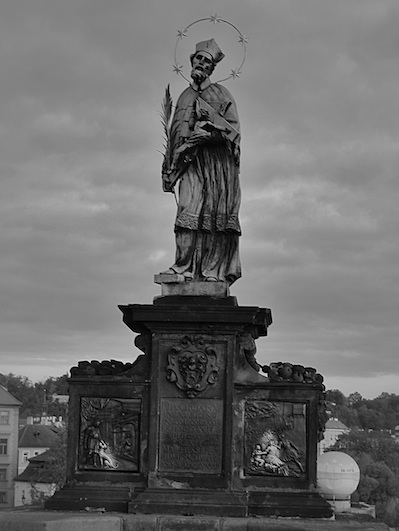
*They’re not as old as their blackened exteriors might have you believe. Actually all of the statues are replicas of the originals, which beginning in 1965 have been housed in the National Museum.
(Photo of Charles Bridge via Chosovi, Wikimedia Commons, St. Nepomuk via Paul Holloway)
June 12, 2012
Saint Nicholas Church
Today from Prague Unbound, we take a look at a church in Mala Strana that housed a different sort of gargoyle during the Communist era.
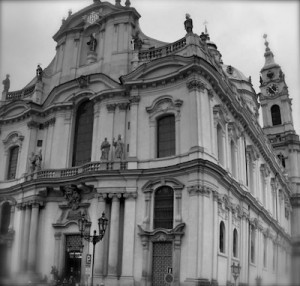 Not to be confused with the St. Nicholas Church just across the river in Old Town, Mala Strana’s Church of St. Nicholas (Kostel svatého Mikuláše ) dates back to the 13th century. Its current incarnation was founded by the Jesuits and built beginning in the early 18th century, though construction on the Baroque church was slowed by outbreaks of the plague and wars. None other than Wolfgang Amadeus Mozart once tickled the ivories of the church’s pipe organ.
Not to be confused with the St. Nicholas Church just across the river in Old Town, Mala Strana’s Church of St. Nicholas (Kostel svatého Mikuláše ) dates back to the 13th century. Its current incarnation was founded by the Jesuits and built beginning in the early 18th century, though construction on the Baroque church was slowed by outbreaks of the plague and wars. None other than Wolfgang Amadeus Mozart once tickled the ivories of the church’s pipe organ.
The high tower of the church was long used a lookout post for spotting fires or the approach of hostile armies. In the 20th century, it served as a not-entirely-different kind of lookout post, as it was used by State Security (StB), the secret police who terrorized Czech citizens during the Communist era. A hidden, tiny room codenamed ‘Kajka’ (and only discovered in 2009) was staffed by the StB because the tower gave them an excellent vantage point from which to monitor the comings-and-goings outside the nearby embassies of France, West Germany, the United Kingdom and the United States. In secret police circles, the post was more commonly known as ‘Dědkárna’ – The Old Geezers Room – as it was usually occupied by agents too old for more exciting missions, say those involving hand-to-hand combat with Sean Connery.
Czech dissidents in the know were well aware of the StB perch though, and would often arrange samizdat exchanges at the tower base, right under the StB’s noses.
(Photo by joyosity, Flickr Creative Commons)
June 7, 2012
Old Jewish Cemetery
Today we turn to Prague Unbound to learn a little about the city’s most famous cemetery.
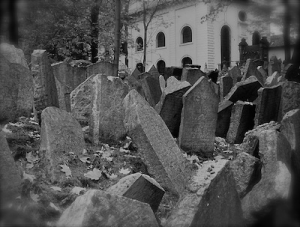 Established in the early 15th century, the Starý židovský hřbitov is the second oldest cemetery in Europe and one of the world’s most storied necropolises, a compressed, angular, uneven plot roughly the size of three tennis courts and crammed with some 12,000 decaying tombstones. Because the Jewish population was long restricted to the walled-in quarter of the ghetto, the cemetery could not expand outward and new bodies were for centuries simply buried atop the old, resulting in a multi-leveled, jumbled burial mound 12 layers deep in which rest the remains of as many as 100,000 people.
Established in the early 15th century, the Starý židovský hřbitov is the second oldest cemetery in Europe and one of the world’s most storied necropolises, a compressed, angular, uneven plot roughly the size of three tennis courts and crammed with some 12,000 decaying tombstones. Because the Jewish population was long restricted to the walled-in quarter of the ghetto, the cemetery could not expand outward and new bodies were for centuries simply buried atop the old, resulting in a multi-leveled, jumbled burial mound 12 layers deep in which rest the remains of as many as 100,000 people.
Built on a scrap of land at time surrounded by, as one writer relates, “bordellos, soaking pits, tanners’ booths and huts inhabited by executioners, outcasts and dog catchers,” its first known grave is that of poet and rabbi Avigdor Kara, a survivor of the pogrom that occurred on the last day of Passover in 1389 and wiped out 3,000 Prague inhabitants, nearly the entire Jewish population of the city. Other famous cemetery residents include historian and astronomer David Gans, wealthy community leader Mordecai Maisel, and the legendary Rabbi Loew, creator of the Golem.
In 1787, burials were banned at the Old Jewish Cemetery for fear that they would help spread a fresh outbreak of the plague. Despite being closed for new business for more than 200 years, the cemetery maintains an disproportionate presence in Prague lore and literature. Nineteenth century German novelist Wilhelm Raabe compared the cemetery to “a bottomless, voracious swamp” and wrote there was no sky so black as the one hanging over the Old Jewish Cemetery during a thunderstorm. Franz Kafka included a veiled reference to it as the setting of one of Josef K.’s disturbing dreams in The Trial (a book which, like most of Kafka’s works, never mentioned the city itself by name but is so inextricably of Prague that such invocations would be redundant), and in 19th century American writer F. Marion Crawford’s best-selling The Witch of Prague, the nameless Wanderer strolls with the titular witch Unorna upon its grounds, a place where “thousands upon thousands of dead Jews, great and small, rich and poor, wise and ignorant” lie “rank upon rank…like columns and files of soldiers shot down in the act of advancing.” A place where “not a murmur of distant life from the surrounding city disturbs the silence” and “the utter desolation and loneliness of the spot have a horror of their own, not to be described, but never to be forgotten.”
A fitting setting then, to inspire the worst horror of the 20th century.
To wit –
In 1868, under the pseudonym Sir John Retcliffe, German anti-Semite Herrmann Ottomar Friedrich Goedsche plagiarized a little-known French satire called The Dialogue in Hell Between Machiavelli and Montesquieu – but crucially added a chapter in which a secret rabbinical cabal meets at Prague’s Old Jewish Cemetery to hatch a plan for world domination.
This chapter was then itself re-plagiarized in the 1890s by Russian scribe Matvei Golovinski and published as a work of nonfiction called The Protocols of the Elders of Zion (a text American industrialist Henry Ford had published on his own dime to the tune of 500,000 copies).
Adolf Hitler took The Protocols a work of historical fact, one he and his pals often cited as justification for their Final Solution.
Thus in circular, distorting-mirror-maze fashion, was the death of millions of Jews launched from the sacred burial place of their ancestral thousands.
The Holocaust wiped out the Jewish population of Prague, but the cemetery itself was left virtually untouched. In the initial days of the 1939 Nazi invasion, troops used the gravestones of the Old Jewish Cemetery for target practice, but this was soon put to a stop as Hitler wanted to preserve the cemetery and the handful of nearby synagogues for a part of a planned museum tracing the history of an extinct race.
See, he wasn’t such a bad guy, as all that. Just one drawn to bad literature.
(Photo via Kyle Simourd, Flickr Creative Commons)
June 5, 2012
Rudolf II
 No figure has done more to shape Prague the actual city and Prague of the popular imagination (as if they could somehow be separated) than Emperor Rudolf II, the reluctant, melancholy king who made the city the seat of the Holy Roman Empire from 1576 to his death in 1612.
No figure has done more to shape Prague the actual city and Prague of the popular imagination (as if they could somehow be separated) than Emperor Rudolf II, the reluctant, melancholy king who made the city the seat of the Holy Roman Empire from 1576 to his death in 1612.Born in Vienna on July 18, 1552, Rudolf II was by double lineage grandson of Spanish queen Johanna the Mad, who lived out her reign confined to a Castilian convent where she was convinced the nuns were conspiring to murder her, ancestry worth mentioning in light of Rudolf’s later mental health problems.
Instead of the more relaxed Austrian court, young Rudolf was raised in the strict, formal and fervently Catholic court of his uncle Phillip II in Madrid. Outside the castle gates the Inquisition raged. Inside El Escorial, Phillip II had assembled some 6,000 holy relics, including the heads of 103 martyrs. Young Rudolf was in Escorial when his first cousin Don Carlos threw a servant out a high window to his death and then attacked a Duke with a knife, actions that resulted in him being imprisoned in a windowless tower. None in the castle were permitted to so much as speak his name, and Don Carlos willfully starved himself to death. Queen Elizabeth, the figure Rudolf and his brother Ernst were closest to at El Escorial, was inconsolable and three days after the death of Don Carlos suffered a miscarriage and died.
Rudolf was relieved to return to Vienna when he was nineteen, but the gloomy Spanish court had already done much to shape his manner, and he was seen as stiff, secretive and aloof. El Escorial’s repressed civility masked constant intrigues and whispering campaigns, and this would also mould Rudolf’s psyche, making him suspicious, paranoid, capable of suddenly turning on his friends and bearing grudges for decades. For the rest of his life, Rudolf II would also adhere to the Spanish courtly custom of dressing in black.
Crowned King of Bohemia in St. Vitus Cathedral in 1575, he would within two years lay his father’s body to rest inside the St. Vitus imperial vault. The year Rudolf became the Holy Roman Emperor, a comet appeared over Europe that was interpreted to as an evil harbinger of troubled times to come.
Given the religious and political schisms roiling the continent, it was a safe prediction. But even early in his reign it was apparent that Rudolf was temperamentally unsuited for matters of state, being far more interested in the arts and sciences. Withdrawing into the recesses of his castle, he would keep foreign dignitaries waiting for months while granting audience to all manner of soothsayers, alchemists, painters and astrologists. Luminaries to win his favor include the likes of astronomers Tycho Brahe and Johannes Kepler, artists Hans von Aachen and Guiseppe Arcimboldo, and poetess Elizabeth Jane Weston. But his interest in the alchemical and the occult also made him vulnerable to swindlers like Michael Sendivogius, Geronimo Scotta and Edward Kelley.
Despite being brought up in the rigidly Catholic Spanish court, Rudolf was extremely tolerant in matters of religion, even going so far as to receive Rabbi Loew in the castle to discuss matters of the cabbala. But his refusal to take sides made both Protestants and Catholics uneasy. His endless pursuit of the Philosopher’s Stone, which would not only help transform base metals to gold but would unite all the sciences and potentially provide the key to eternal life, did not sit well with papal authorities, who suspected him of being a heretic and credited rumors that he dabbled in necromancy.
Rudolf believed the Jesuits to be Vatican spies (often rightly so) and loathed the chanting of the Capuchin monks. His distaste was partly driven by fear, as it had been foretold that he would die by a monks’ hand – it had also been prophesized by Tycho Brahe that his fate was tied to that of a pet lion named Otakar given to him by the Sultan of Turkey. Rudolf was greatly annoyed by what he saw as the Catholic Church’s constant meddling in his affairs, particularly their concern over his successor.
Rudolf never married, despite attempting for more than twenty years to secure a union with Isabella of Spain (who instead married Rudolf’s brother Matthias – ouch). He did father several children out of wedlock, including six with his mistress Catherina Stradova, daughter of the man who for years was in charge of cataloguing the Emperor’s vast collection of art and esoteria (Rudolf’s favored illegitimate son Don Giulio kidnapped, raped and stabbed to death a barber’s daughter named Maruška. Authorities discovered him locked in a room in Krumlov Castle, naked, covered in feces and embracing the poor girl whose teeth he’d smashed and eyes gouged out. Like Rudolf II’s cousin Don Julius, Don Giulio was locked away in a dungeon never to be heard from again).
Rudolf’s bouts of melancholy grew worse as he aged and became ever more withdrawn and suspicious. Often he would spend long nights alone wandering hisKunstkammer, a collection of artifacts and naturalia unparalleled in the history of Europe. Objects in his immense collection included ancient coins and precious stones, arcane mystical manuscripts, perpetual motion machines, unicorn horns, the jawbone of a siren who’d lured Odysseus’ ship to shore, two nails from Noah’s Ark, a goblet fashioned from a rhinoceros horn, whale teeth, demons imprisoned in blocks of glass (which makes us laugh heartily indeed), musical instruments, muskets, daggers, ostrich eggs, misshapen fetuses (which makes us laugh for different reasons), Egyptian mummies, astrolabs, a silver bell for summoning the dead, a painting by Albrecht Durer he’d had transported over the Alps by four men charged with carrying it upright, musical clocks, clocks shaped like boats, clocks built into the shells of turtles, clocks (or at least one, at least for awhile) that ran both backward and forward at the same time.
Rudolf’s isolation, paranoia and disinterest cost him power years before he lost his life, as all duties of the kingdom were taken over by his hated brother Matthias. In the end Tyco Brahe’s prophecy proved true, for the unhappy king shuffled off his mortal coil on January 12, 1612, just three short days after the death of his favorite lion.
Rudolf’s death marked the end of Prague’s golden age, a brief period when it was the intellectual and scientific capital of Europe, when anything, be it making gold from lead or achieving eternal life, seemed possible. In the 400 years since, it’s all been pretty much downhill.
And though we certainly can’t take all the credit for how it turned out, we’d like to think we played our part.
(Image public domain)
June 1, 2012
Čertovka – The Devil’s Stream
Today we turn to Prague Unbound, the odd guidebook acquired by Lee Holloway on his journey to Prague, to learn a little about the Čertovka canal.
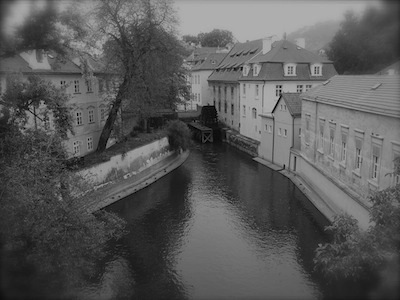 Built in the Middle Ages to power millwheels, like many Prague landmarks Čertovka takes its name from a rather dark legend. Not so many hundreds of years ago, along the banks of the canal lived a woman so ill-tempered and vicious that local villagers painted devils upon her house as a warning to passersby. Her dwelling became known as the House of Seven Devils, and because the canal ran by her house and she washed her foul clothes in its waters, it became known as Čertovka – ‘The Devil’s Stream.’ It said on certain nights you can still see her cursing and spitting and washing her clothes in the coal black water – but be careful. If she catches you looking, legend has it you will be dead in the span of seven days.
Built in the Middle Ages to power millwheels, like many Prague landmarks Čertovka takes its name from a rather dark legend. Not so many hundreds of years ago, along the banks of the canal lived a woman so ill-tempered and vicious that local villagers painted devils upon her house as a warning to passersby. Her dwelling became known as the House of Seven Devils, and because the canal ran by her house and she washed her foul clothes in its waters, it became known as Čertovka – ‘The Devil’s Stream.’ It said on certain nights you can still see her cursing and spitting and washing her clothes in the coal black water – but be careful. If she catches you looking, legend has it you will be dead in the span of seven days.
Čertovka is also home to a pipe-smoking water sprite (vodník) named Kabourek, who in bygone days was such a faithful patron of the local taverns that innkeepers would bring him a bucket of water in which to soak his webbed feet as he drank beer so that he felt more at home. But times change, and now that Kabourek is no longer allowed inside the taverns, he usually stays deep underwater, surrounded by the rich antiques Castle invaders have throughout the centuries cast into the canal (including, it’s said, a fine portrait of Emperor Rudolf II). But sometimes his thirst overwhelms him and he comes to the surface to beg passersby to bring him beer – if they do, he usually reciprocates with an eel. If they refuse, he attempts to drown them.
You may be tempted to dip into the canal for a little swim. Think carefully before you do. There are worse things than Kabourek lurking in its waters.
(Photo via Paul Holloway)
May 30, 2012
COMPLICATION Book Club Discussion Guide
Below are some gentle suggestions for points of discussion should your reading group or book club dare to take on COMPLICATION.
At the outset of the novel, Lee Holloway has a muted, numb reaction to his father’s death. His only emotional break comes during the wake, when he considers punching a wall. Have you ever punched a wall? What did it feel like? What were the repercussions among your friends and family?
In the first historical section of the novel, Eliška Reznícková is being interrogated by the secret police for a crime they initially refuse to name, but has somehow to do with accordions. Have you ever found yourself in a similar situation? How did you react? Also, what do you think of accordions? Did you know polka music was actually invented in Prague? Well, it was.
At one point, Lee Holloway decides to pose as a local journalist when trying to get information about his brother’s disappearance. Did you see the season finale of Walking Dead? What the hell was that thing with the armless zombies on chains? That was awesome.
Throughout the book, Lee Holloway struggles with how much to trust Vera, his brother’s former girlfriend and criminal co-conspirator. Did you try this wine? It’s a Pinot Gris – different from Pinot Grigio. It’s really good.
Alchemist Edward Kelley dreams up the Rudolf Complication in order to impress the Holy Roman Emperor Rudolf II. Have you ever promised something you might not be able to deliver in order to win the favor of your boss? How did you deal with the situation? Did you seek supernatural intervention? Did you fear if you did not deliver on your promise that you would be tortured and/or killed? I can’t believe how much it’s raining this year.
Part of the book is set in on the eve of the Nazi invasion of Czechoslovakia in 1938 following the Munich Agreement. Jan Murcek, an elderly antiques dealer, is reluctant to leave Prague even though he knows hard times are surely coming. Have you ever been reluctant to leave somewhere even though part of you knows its time to go? I mean, it’s getting kind of late. The food is all gone and the only wine left is that swill that Laura brought. We all have to get up in the morning. Don’t you think its maybe time to, you know, head out?
May 29, 2012
Malá Strana
Today we turn to Prague Unbound, the odd guidebook used by Lee Holloway on his journey to Prague, to learn a little about Malá Strana.
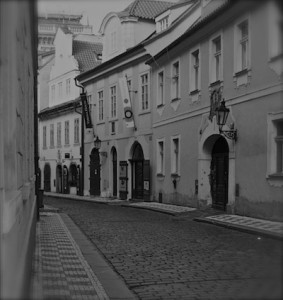 Known as the “Lesser Quarter,” Malá Strana lies on the sloping west bank of the Vltava River. Beginning in the mid 13th century, the area incorporated several neighborhoods living in the shadow of Hradshin Castle. In 1591, alchemist Edward Kelley killed courtier Jiří Hunkler in a duel outside Malá Strana’s At the Donkey in the Cradle tavern, an act many believe lead to his downfall (hogwash, says we who know his downfall better than he ever knew it himself).
Known as the “Lesser Quarter,” Malá Strana lies on the sloping west bank of the Vltava River. Beginning in the mid 13th century, the area incorporated several neighborhoods living in the shadow of Hradshin Castle. In 1591, alchemist Edward Kelley killed courtier Jiří Hunkler in a duel outside Malá Strana’s At the Donkey in the Cradle tavern, an act many believe lead to his downfall (hogwash, says we who know his downfall better than he ever knew it himself).
The neighborhood’s most famous former residents include writer Karel Čapek — who introduced the word “robot” to the world — and poet Jan Neruda. Current well-known inhabitants include a drunken monk from the Strahov monastery cursed on rainy nights to wander Úvoz Street in search of his missing head, a similarly headless horseman who each Friday at midnight rides a flaming black carriage down Jánský vršek Street, and the ghost of a cuckholded locksmith with a rusty nail driven through his skull, condemned to wander Tomášská Street in search of some soul brave enough to remove the spike and release him from his torment. According to one 20th century novelist, “the air in Malá Strana is more sinister than any other in the world.” Think the air is sinister now, you should have been there in the days before indoor plumbing.
You, Dear Reader, would be well advised to steer clear of the area. But we know you won’t.
(Photo via Paul Holloway)
May 24, 2012
St. Vitus Cathedral
Today we turn to Prague Unbound, the curious guidebook used by Lee Holloway on his journey through Prague, to learn a little about the famous St. Vitus Cathedral.
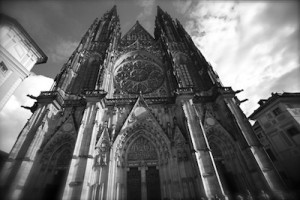 Today part of the Hradcany castle complex on the West bank of the Vltava River, St. Vitus Cathedral had its humble beginnings in 925 when Wenceslaus I, Duke of Bohemia, came into possession of the severed arm of St. Vitus – a holy relic given him by Emperor Henry I (history makes no note of any gift Wenceslaus might have given the Emperor in return). Wenceslas was in 929 murdered by his pagan brother Boleslav the Cruel, who later repented, converted to Christianity, and interred his brother’s remains in the church.
Today part of the Hradcany castle complex on the West bank of the Vltava River, St. Vitus Cathedral had its humble beginnings in 925 when Wenceslaus I, Duke of Bohemia, came into possession of the severed arm of St. Vitus – a holy relic given him by Emperor Henry I (history makes no note of any gift Wenceslaus might have given the Emperor in return). Wenceslas was in 929 murdered by his pagan brother Boleslav the Cruel, who later repented, converted to Christianity, and interred his brother’s remains in the church.
In 1344, Charles IV built a cathedral on the site dedicated to the patron saint of clowns, dogs, actors, and epileptics, an entity also charged with protecting against lightning strikes and oversleeping. Peter Parler, designer of the Charles Bridge and other Prague wonders, is the architect most associated with the cathedral’s long construction, which was interrupted several times by wars and fires and whole centuries of inertia.
This cathedral “where incense swims like memory” houses the remains of, among others, John of Nepomuk, who in 1393 was by King Wenceslas’ thugs tortured and thrown from the Charles Bridge to drown in the Vltava when he would not give up confessional secrets of the Queen. When Nepomuk’s tomb was opened three centuries later and his uncorrupted tongue spilled still pink and damp out of his skull he was canonized almost instantly, Pope Benedict XIII uttering the words Numquam mus in amicis et semper ore clausa (‘Never rat on your friends and always keep your mouth shut’).
(Photos via Arash Ayrom)
May 21, 2012
Vltava River
Today we turn to Prague Unbound, the odd guidebook used by Lee Holloway on his journey to Prague, to learn a little about the famous river coursing through its center.
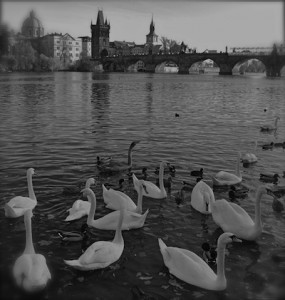 Coursing through the heart of Prague, the Vltava River (its name is derived from the old Germanic word for “wild water”) is the longest river in the Czech Republic, running some 267 miles before merging with the Elbe River. Classical composer Bedřich Smetana wrote his most famous tune in its honor — before later going deaf and being plagued by depression and madness — and the river features heavily in the city’s mythology. The wise woman Libuše prophesized Prague’s founding while standing at a cliff overlooking its waters and was said to cast off her discarded lovers into its depths, the Golem was by legend made from the mud of its banks, St. John of Nepomuk was drown in its currents (as was Paul Leppin’s poor fictional Hans who fell in love with a wax doll named Maria).
Coursing through the heart of Prague, the Vltava River (its name is derived from the old Germanic word for “wild water”) is the longest river in the Czech Republic, running some 267 miles before merging with the Elbe River. Classical composer Bedřich Smetana wrote his most famous tune in its honor — before later going deaf and being plagued by depression and madness — and the river features heavily in the city’s mythology. The wise woman Libuše prophesized Prague’s founding while standing at a cliff overlooking its waters and was said to cast off her discarded lovers into its depths, the Golem was by legend made from the mud of its banks, St. John of Nepomuk was drown in its currents (as was Paul Leppin’s poor fictional Hans who fell in love with a wax doll named Maria).
The river has long acted as home for the vodník – bearded, web-fingered water sprites who dress as vagabonds and spend leisure hours smoking pipes and playing cards when not collecting the souls of the drowned inside lidded porcelain cups (a bubble rising to surface of the river means a dead soul has escaped vodník containment).
The River has a habit of unleashing devastating floods upon the city, two of the worst occurring in 1890 and 2002 (as you, Kind Reader, know all too well). The Vltava has been described as “a repository of tears, source of the malady of melancholy”, a river that came “from faraway…time could do nothing to suppress its fury, its wild grief…”
Others claim the grandiose river is actually “only four millimeters deep, and filled with leeches.”
(Photo via Ivan Mlinaric. Flickr Creative Commons)

